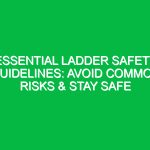“`html
Essential Landscaping Safety Guidelines: Avoid These Critical Risks
Good morning team,
Today, we’re going to discuss an essential topic that directly impacts our Safety and well-being on the job: Essential Landscaping Safety Guidelines: Avoid These Critical Risks. Understanding and implementing these guidelines is crucial for ensuring a safe working environment for everyone involved in landscaping operations.
Landscaping can be a rewarding job, but it also comes with significant Hazards. By being aware of these risks and knowing how to mitigate them, we can protect ourselves and our coworkers. So let’s dive into why these safety guidelines are vital and how we can apply them in our daily operations.
Understanding Essential Landscaping Safety Guidelines
The term Essential Landscaping Safety Guidelines encompasses a comprehensive set of practices designed to safeguard our employees from various risks associated with landscaping work. These guidelines include everything from proper equipment handling to safe worksite practices.
Understanding these guidelines is not just about compliance; it’s about fostering a culture of safety that prioritizes our health and well-being. A common misconception is that Safety Measures are an inconvenience or a hindrance to productivity. In reality, they are tools that help us work more efficiently and reduce downtime caused by accidents.
Key Hazards, Risks, and Safety Considerations
Several specific hazards and risks are inherent in landscaping work. Let’s discuss some of these critical risks:
- Equipment Mishaps: Improper use of tools such as lawnmowers, trimmers, and blowers can lead to severe injuries.
- Slips, Trips, and Falls: Uneven ground, slippery surfaces, and clutter can easily cause accidents.
- Exposure to Chemicals: Pesticides and fertilizers pose health risks if not handled correctly.
- Heat Stress: Working outdoors can lead to heat exhaustion or heat stroke, especially during the summer months.
- Electrical Hazards: Using electric tools near water sources presents a significant risk of electrocution.
Ignoring these safety protocols can lead to real-world consequences, including serious injuries, long-term health issues, and even fatalities. Each of us has a responsibility to recognize these hazards and act accordingly.
Best Practices, Procedures, & Actionable Advice
To ensure safety while working in landscaping, here are some Best Practices and Procedures you should follow:
- Proper Training: Always undergo training before using any new equipment. Familiarize yourself with the operating manual.
- Wear Personal Protective Equipment (PPE): Always wear appropriate gear such as gloves, goggles, hearing protection, and steel-toed boots.
- Inspect Equipment: Before starting your work, check all tools and equipment for defects or wear. Always report any issues immediately.
- Maintain a Clean Work Area: Keep the worksite tidy to prevent slips and trips. Dispose of debris and tools properly.
- Stay Hydrated: Drink plenty of water, especially on hot days. Take regular breaks in shaded areas to avoid heat-related illnesses.
Let me share a brief example: Last summer, one of our crew members neglected to wear PPE while using a weed trimmer. As a result, they suffered a deep cut that required stitches. This incident could have been easily avoided by adhering to safety guidelines and wearing the necessary protective gear.
Regulations, Standards, and Compliance
It’s crucial to be aware of the Regulations and Standards that govern our work environment. Organizations like OSHA (Occupational Safety and Health Administration) have established guidelines to protect workers in landscaping and other outdoor occupations.
Compliance with these standards is not merely a legal requirement; it’s a fundamental aspect of our responsibility to ensure a safe workplace. Adhering to these regulations helps prevent accidents and injuries, ultimately protecting our health and our livelihood.
Employee Engagement & Discussion
Now that we’ve covered essential landscaping safety guidelines, I want to hear from you! What safety challenges have you encountered related to landscaping work? Have you experienced any close calls or incidents that you think we can learn from?
Discussing these experiences can help us all learn and grow in our safety practices. Your insights are valuable in creating a safer workplace for everyone.
Conclusion & Key Takeaways
In conclusion, adhering to essential landscaping safety guidelines is critical for our health and safety. Remember to:
- Always use PPE when operating equipment.
- Keep your work area clean and organized.
- Stay hydrated and take necessary breaks.
- Report any safety hazards or equipment issues immediately.
By prioritizing these practices, we can minimize risks and ensure that everyone goes home safe and sound at the end of the day. Thank you all for your attention and commitment to safety. Let’s make this a safe and productive workday!
“`


